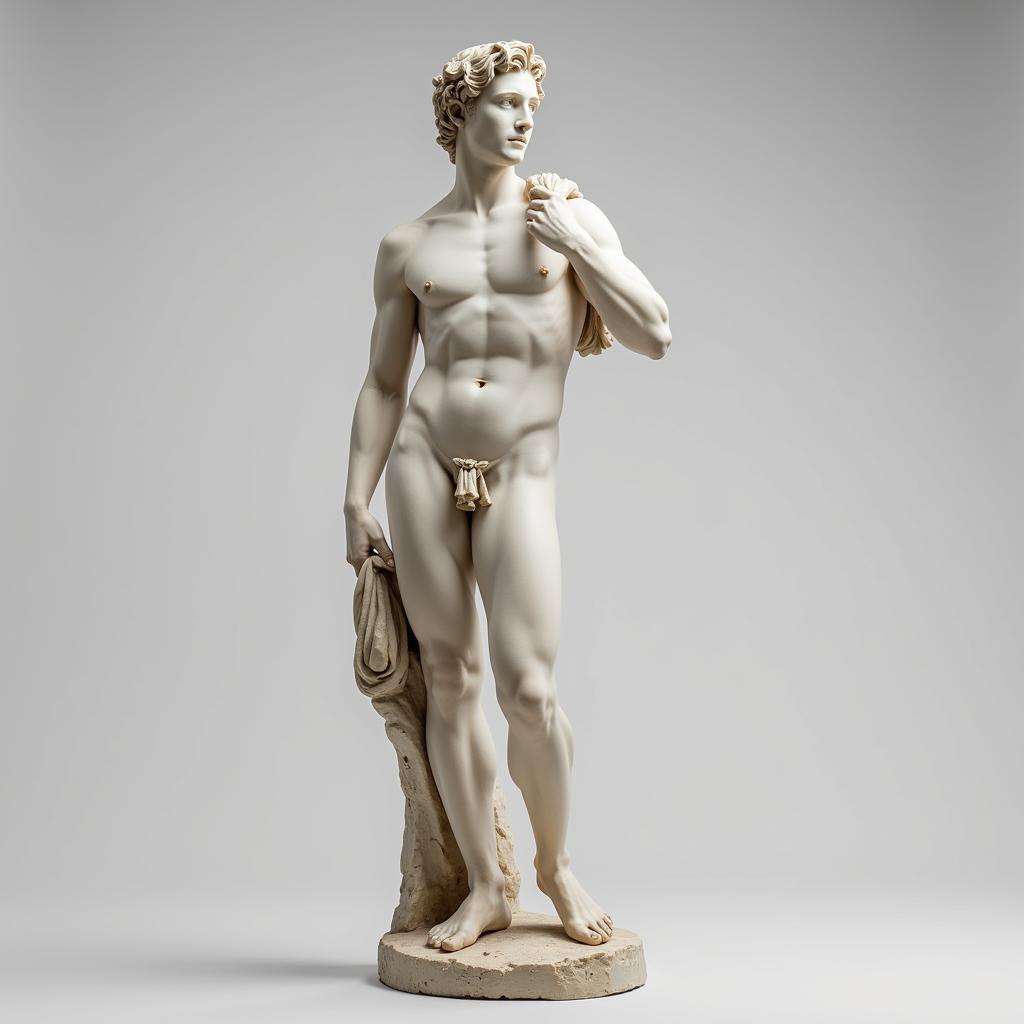Exploring the Enduring Power of Classic Nude Art
Classic Nude Art, a genre spanning centuries and cultures, continues to captivate and challenge viewers. From the graceful sculptures of ancient Greece to the evocative paintings of the Renaissance masters, the nude form has served as a powerful subject for artistic exploration. This article delves into the historical context, artistic techniques, and cultural significance of classic nude art, shedding light on its enduring appeal and its ability to spark dialogue even today.
A Journey Through Time: Tracing the Evolution of Nude Art
 Ancient Greek Sculpture of a Nude Male Figure
Ancient Greek Sculpture of a Nude Male Figure
The depiction of the nude figure in art dates back to prehistoric times, with examples like the Venus of Willendorf figurine suggesting early symbolic representations of fertility and the human form. However, it was in ancient Greece where nude art truly flourished as a celebrated art form. Greek artists, fascinated by the human physique, meticulously studied anatomy and proportions, seeking to capture the idealized beauty of the human body. Sculptures like the iconic Venus de Milo and the Discus Thrower exemplify the Greek reverence for the nude form, emphasizing harmony, balance, and athleticism.
With the rise of the Roman Empire, nude art continued to hold a prominent place, often incorporating Greek artistic ideals while also exploring themes of power and mythology. Roman sculptures, like those adorning bathhouses and villas, showcased both realistic and idealized depictions of the human body, reflecting the Roman fascination with physicality and the pursuit of leisure.
The Renaissance Revival: Nude Art as a Celebration of Humanism
 Renaissance Painting Depicting the Birth of Venus
Renaissance Painting Depicting the Birth of Venus
The Middle Ages witnessed a decline in the prevalence of nude art in Europe, as religious themes dominated artistic expression. However, the Renaissance marked a resurgence of interest in classical art and ideals, including the celebration of the human form. Artists like Leonardo da Vinci, Michelangelo, and Raphael drew inspiration from Greek and Roman art, incorporating the nude figure into their masterpieces to convey a renewed appreciation for human anatomy, beauty, and the pursuit of knowledge.
Michelangelo’s David, for instance, stands as a testament to the Renaissance ideal of the perfect human form, embodying strength, grace, and the spirit of human potential. Similarly, Botticelli’s Birth of Venus showcases the graceful lines and idealized beauty of the female form, reflecting the Renaissance fascination with classical mythology and the allure of feminine beauty.
Beyond the Physical: Nude Art and the Exploration of Emotion
 Impressionist Painting of a Woman Bathing in a Sunlit Room
Impressionist Painting of a Woman Bathing in a Sunlit Room
While classic nude art often emphasized idealized beauty and technical mastery, it also served as a canvas for exploring a range of human emotions and experiences. From the sensual poses of Titian’s Venus of Urbino to the melancholic gaze of Manet’s Olympia, nude art transcended mere physical representation to convey complex themes of love, desire, vulnerability, and even societal critique.
Nude Art in the Modern Era: From Scandal to Acceptance
The 19th and 20th centuries saw nude art continuing to evolve, with artists pushing boundaries and challenging traditional norms. Impressionists like Renoir and Degas captured the fleeting beauty of the human form in everyday life, while Expressionists like Egon Schiele used distorted figures and bold lines to convey raw emotion and psychological depth.
The depiction of the nude in art has not been without its controversies. From Manet’s Olympia, which sparked outrage for its unflinching portrayal of a nude prostitute, to contemporary works that challenge traditional notions of beauty and gender, nude art has consistently provoked dialogue and pushed the boundaries of artistic expression.
Frequently Asked Questions About Classic Nude Art
1. What is the purpose of nude art?
Nude art serves a myriad of purposes, from celebrating the beauty of the human form to exploring complex themes of sexuality, identity, and the human condition. It can be a tool for technical mastery, emotional expression, and social commentary.
2. Why is nude art considered art and not pornography?
The distinction between art and pornography lies in the intent and context of the work. Nude art, particularly classic nude art, often emphasizes artistic elements like composition, technique, and thematic depth, aiming to evoke aesthetic appreciation or intellectual engagement, rather than purely sexual arousal.
3. What are some famous nude art pieces?
Some of the most celebrated nude art pieces include:
- Venus de Milo (Ancient Greece)
- Discus Thrower (Ancient Greece)
- David (Michelangelo)
- Birth of Venus (Botticelli)
- Venus of Urbino (Titian)
- Olympia (Manet)
- The Bathers (Renoir)
Exploring Further: Delving Deeper into the World of Art
Classic nude art, with its rich history and evolving styles, continues to offer a fascinating lens through which we can examine human creativity, cultural values, and the timeless allure of the human form. From the idealized sculptures of antiquity to the thought-provoking paintings of modern masters, nude art remains a powerful and enduring form of artistic expression, inviting viewers to contemplate the complexities of the human experience.
Need assistance? Contact us at Phone Number: 02462573573, Email: [email protected] Or visit us at Savico Megamall, 7-9 Đ. Nguyễn Văn Linh, Gia Thụy, Long Biên, Hà Nội 10000, Việt Nam. Our customer service team is available 24/7.



